
On the Cover: The moons Triton (right) and Proteus look down upon one of Neptune’s deep blue storms, a cloud whorl thousands of kilometers across. White clouds of methane ice crystals swirl above the maelstrom, drifting over sporadic lightning. Artist Michael Carroll painted this work in acrylic, and then added digital enhancements.
Download PDF
CONTENTS
Advocating for Space
Change Comes to Washington
Casey Dreier assesses the sea change brought about by midterm elections in the United States—and what it might mean for space-science policy.
Amy Simon offers a glimpse of the latest discoveries on Uranus and Neptune—and discusses what we still don’t know.
Ethan Kruse provides a visual (and animated!) representation of the Kepler mission’s exoplanet discoveries.
Hannah Wakeford seeks to understand the natures of watery, gassy, cloudy, and rocky distant worlds.
Society News
Up for a Challenge?
Richard Chute introduces the grand dames of planetary defense, and Kate Howells reports on volunteers’ work in Lebanon.
Developments in space science
Scientific Progress
Bruce Betts reports on Planetary Deep Drill progress, new efforts for planetary defense, and LightSail 2’s status.
Emily Lakdawalla shares a vision of an unimaginably dark and distant world—one of millions.
Four planets and both lunar and solar eclipses will grace Earth’s skies this quarter.
Bill Nye reveals our plans to make “Space for Everyone.”
Emily Lakdawalla says goodbye to a Mars lander and hello to a lunar one.
Snapshots From Space
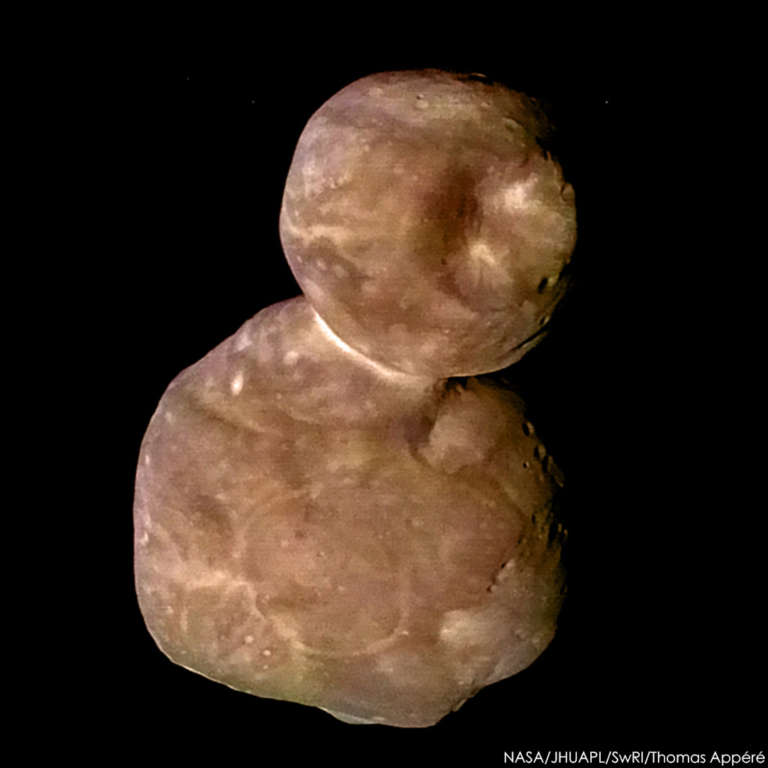
It's one among millions. Nothing special drew New Horizons to 2014 MU69 (nicknamed “Ultima Thule”), except that it was in the right place at the right time for the fast-flying spacecraft to zip past it. And yet, merely by visiting it, we made 2014 MU69 special, turning it from a dot in the sky so faint that it’s only visible to Hubble into the double-lobed world in this photo. New Horizons will spend another year returning all its data from the encounter, and scientists will spend years—perhaps decades—debating how this odd little binary thing formed and evolved. In the meantime, data artists like Thomas Appéré will help us imagine what 2014 MU69 would look like if we could only travel the more than 6 billion kilometers (4 billion miles) that separates Earth from it.
See more amateur-processed space images.
Space for Everyone
What We Do—and What We Want to Do
Bill Nye is chief executive officer of The Planetary Society.
I DON’T KNOW about you, but for me, the last 5 years have flown by. Normally, I would include a joke here about how the flying would have been silent because we’re in outer space, but actually, it’s been a bustling buzz here at The Planetary Society, which is still firmly on Earth.
With these 5 years behind us, it was time to create another 5-year plan. We call it “Space for Everyone.” Check it out at planetary.org/spaceforeveryone. For me, the key to our future is you. You are the doers. You are the people who will find life elsewhere, protect Earth from an incoming massive asteroid or comet, and reach into outer space to explore other worlds.
As I’m pretty sure you know, our staff—your staff—has been helping us grow the organization by keeping you informed, responding to your needs, and connecting more of the world’s citizens to the adventure of space exploration than ever before. Guided by our last strategic plan, our membership—which comprises people like you—grew more than 20 percent to 50,000. Together, we flew our LightSail 1 spacecraft. We are leaders in planetary defense and solar sailing. We established international relationships and guided the creation of a Planetary Science Caucus in the U.S. Congress. Our presence in Washington, D.C. is now full time. We hope to someday have a similar presence near the headquarters of every space agency in the world.
With you in mind, we set some ambitious but achievable goals for the next 5 years. We want to have 75,000 members who carry out 1 million actions for space by 2023. We want you to sign petitions, volunteer in your communities, crowdfund space technology, share space stories, help recruit new members, and get involved in citizen science. Our mission is to enable you to participate in the advancement of space exploration and science. With more members and more actions, The Planetary Society proves public support for space exploration. That proof helps fuel future exploration.
I strongly believe that we are on the verge of finding life elsewhere. Such a discovery would be historic and on the scale of discoveries made by people like Copernicus and Galileo. It would be profound. It would change the way each of us feels about being a living thing in the cosmos. This discovery will not be made by an individual but by a species—our species—on its planetary home world. By the way, the cost to any one of us will be almost unnoticeable because planetary exploration is an amazingly good bargain. In many ways, the same is true with regard to giving an incoming impactor a nudge to save our world. It will be extraordinary and inspirational for all humankind.
As your CEO, it’s my job to make sure we put our time, our treasure, and especially our staff’s remarkable talents to best use. I’ll do my very best. So, watch this space for firm plans to connect more of you more strongly to outer space as we get this ball rolling or rocket nozzle thrusting. The Planetary Society has worked the last 39 years to make space an adventure to be shared by people all over this planet. Thanks for your continued support. Let’s go!
Space For Everyone
Our new 5-year framework will guide decision making as we build on our past to create an inspiring future. Here are some examples:
SUCCESS!
The LightSail project sparked the imaginations of millions of people and is propelling other innovative space projects. We plan to build on this success and invest more in science and technology projects.
SUCCESS!
We have dramatically increased citizen engagement in policy and advocacy and are cultivating relationships with key decision makers. We now have “a seat at the table” and will push governments to increase funding for space exploration.
SUCCESS!
For decades, we have funded near-Earth asteroid detection, tracking, and research. We will protect our planet from dangerous space rocks by supporting asteroid deflection technology and international response strategies.
GROWTH!
We will strengthen our international presence as advocates with the world’s space agencies and as a worldwide network for space professionals and enthusiasts. We want Planetary Society members to feel part of a global community.
GROWTH!
We are on the verge of answering some of humankind’s deepest questions: “Where did we come from?” and “Are we alone?” The Planetary Society considers answering these questions to be a fundamental goal of space exploration. We will fund more projects, educate the public, and advocate with policymakers for the search for life.
GROWTH!
We’ve been listening to you, our members, and will invest in new ways to enhance your connection to space exploration. We aspire to provide a high-quality member experience, unite our members through a digital community, and organize more in-person activities.
Together, we will advance space science and exploration in pursuit of our shared vision: to know the cosmos and our place within it. See the full story at planetary.org/spaceforeveryone.
Change Comes to Washington
A Wave Election Wiped out Congress’ Top Space Supporters
Casey Dreier is chief advocate and senior space policy adviser for The Planetary Society.
THE ONLY CONSTANT in politics is change, so the saying goes. Change in the United States Congress tends to be incremental and even predictable due to regular staff turnover, jockeying for leadership positions, and shifting constituent demands. However, every now and then, Congress changes abruptly, disrupting our continuous mental model with an abrupt discontinuity that inverts political dynamics. We call these political discontinuities “wave elections.” In the fall of 2018, the United States Congress experienced a wave election, one requiring policy advocates everywhere to step back and rebuild their plans.

The wave was a gain of 40 seats in the House of Representatives by the Democratic Party, which captured control of the chamber for the first time since 2010 with the largest popular vote margin for a minority party since 1942. Additionally, Congress experienced a large number of retirements, adding to the turmoil. Together, these effects created a freshman legislative class of 111 new members—an unusually high turnover rate of 21 percent.
The wave washed out Congress’ most dedicated supporters of space exploration. John Culberson (R-TX-07), chair of the powerful House commerce, justice, and science appropriations subcommittee, lost his seat after serving for 18 years. Culberson was the prime mover behind the hundreds of millions of dollars directed annually to the Europa Clipper and lander missions. He was also the co-chair of the Planetary Science Caucus. In the Senate, Bill Nelson (D-FL), the only sitting member of Congress to have flown in space, also lost his reelection bid. Many other members of NASA’s oversight committees and the Planetary Science Caucus lost their seats as well.
Caucuses are ephemeral institutions bound to a specific Congress. They must be rechartered every 2 years. The Planetary Society’s new chief of Washington operations, Brendan Curry, has been hard at work meeting with new members and working to rebuild the caucus membership. Already Rep. Steven Palazzo (R-MS-04) has stepped up to serve as co-chair with Rep. Derek Kilmer (D-WA-06), maintaining its bipartisan nature.
That is just the beginning. Many key congressional committees have new leadership, bringing with them new priorities. Unfortunately, none of them appear eager to take the mantle of chief advocate for exploring Europa, though we will work hard to get them on board. That requires ongoing efforts to forge relationships with hundreds of legislators—no easy task for a small policy team like ours.
Fortunately, we can depend on you—our members—for help. In the first week of March, more than 100 of your fellow Planetary Society members from 25 states trekked to Washington, D.C. as part of our annual Day of Action. They met with members of Congress old and new to promote space science and exploration. Their remarkable commitment to space advocacy will ensure that The Planetary Society can safely surf these waves of change instead of getting washed out to sea.
The Realm of the Ice Giants
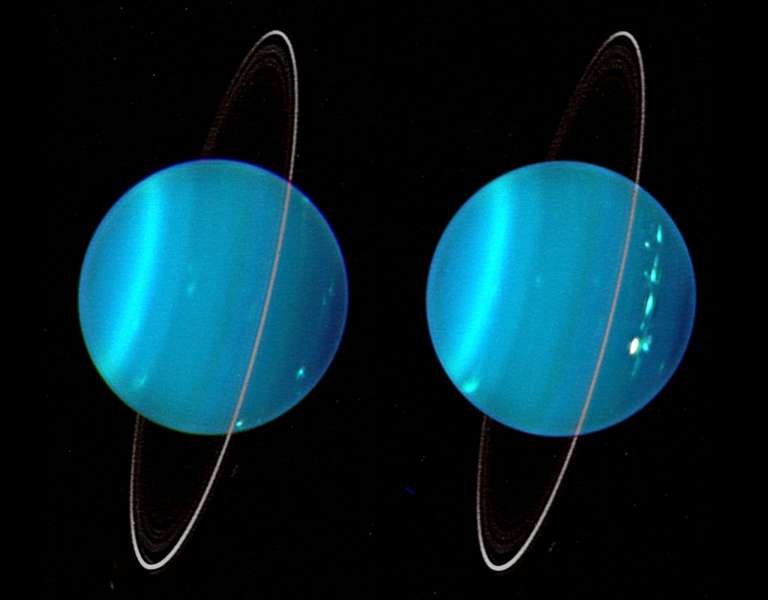
A Kepler Orrery
Sniffing the Air of Other Worlds to Learn How Planets Formed and Evolved
Up for a Challenge?
The Grand Dames of Planetary Defense
Richard Chute is The Planetary Society’s chief development officer.
Curious about our matching gift challenges? Our appeal letters often feature challenges from generous Planetary Society members. Some allow us to identify them by name, but some, out of modesty, often prefer to remain anonymous. I’m excited to lift the curtain on two of these mysterious donors who generously support our Shoemaker NEO grant program.
Allow me to introduce you to Connie (still too modest to share her last name!) and to Eleanor Masin. Together, they have taken up the cause of protecting our planet from near-Earth objects. Through their matching gift challenges over the past several years, they have powered our Shoemaker NEO grants to new heights. Through gifts exceeding $53,000 over 5 years, they have attained more than $100,000 for amateur astronomers dedicated to finding, tracking, and characterizing dangerous near-Earth objects.

Connie, a member for 19 years, says that The Planetary Society is one of her highest philanthropic priorities. At age 89, Connie does not feel computer savvy, so she keeps up with the Society through The Planetary Report. Living on the east coast of Florida, Connie eagerly anticipates the launch of LightSail 2 later this year.
For Eleanor, The Planetary Society came into focus when she and her husband, John, wanted to make gifts in memory of their son, Jonathan, who passed away in 2014. She introduced Jonathan, an accomplished amateur astronomer and photographer, to the night skies as a young boy. Through her challenge gifts, Eleanor honors his memory by supporting amateur astronomers as part of the Shoemaker NEO grant program.
Are you up for a challenge? Watch for our Shoemaker NEO appeal later this year!
Coming Together for Space
by Kate Howells, The Planetary Society's global community outreach manager
For 2018’s World Space Week, Wael Bazzi, outreach coordinator for the Middle East and North Africa, connected with various universities and space societies across Lebanon to help organize a series of events to celebrate space.
Among them was the astronomy club at the American University of Beirut, represented by psychology student Rayan Abdel-Baki, a recently appointed point of contact with SGAC (Space Generation Advisory Council).
As Abdel-Baki describes, “The major challenge facing World Space Week Lebanon was simple: students across the country lacked context and engagement when it came to the significance of space in our everyday lives.”
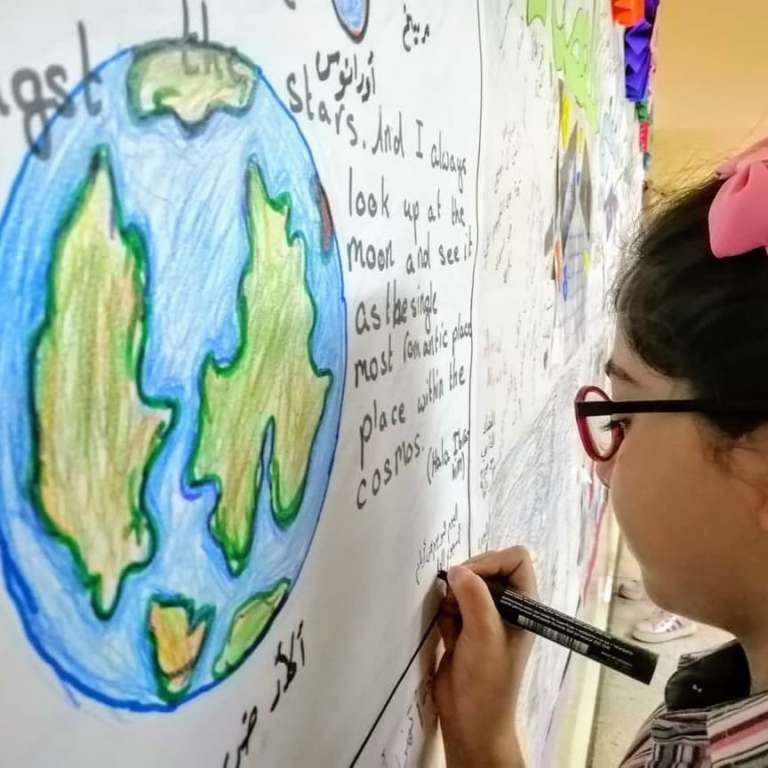
With Bazzi’s mentorship, these space-interested groups came together under one banner. They organized an ambitious, week-long series of events across the country. Seminars on exoplanets, galaxy mapping, astrophotography, and the search for extraterrestrial life delivered in-depth information to students, while space-themed arts and crafts workshops and stargazing trips engaged nonstudents and younger children.
“The World Space Week celebration was a sign that Lebanon is ready to be involved once more with the everevolving discussion about our place in space,” says Bazzi. “It is important to continue cultivating that discussion.”
Scientific Progress
Projects Keep Moving Forward at The Planetary Society
New Horizons just completed a thrilling flyby of Kuiper belt object 2014 MU69 (nicknamed “Ultima Thule”), and Planetary Society members’ names did too. The Planetary Society has long flown members’ names on spacecraft. In the last few months, member names have participated in many deep-space encounters. In addition to New Horizons, we’ve gone into orbit around the asteroid Bennu on board the OSIRIS-REx spacecraft and landed on the asteroid Ryugu on target markers dropped on the surface to guide Hayabusa2 to its own landing. Learn more about the names on these and other missions at planetary.org/namesinspace.

Planetary Deep Drill Tests
Planetary Deep Drill is a technology concept being developed to drill hundreds of meters or more into planetary ices like those at the poles of Mars and the surface of Europa. Honeybee Robotics successfully completed testing of Planetary Deep Drill in December 2018 at a gypsum mine in southern California. This round of tests followed up on tests sponsored by The Planetary Society that were conducted in 2015 at the same mine. Why a gypsum mine? Gypsum has similar mechanical properties to water ice at extremely cold temperatures.
What began as a single drill project has now evolved into two variants. The current round of tests incorporated a miniaturized version of an actual spacecraft flight instrument: the Mars 2020 rover’s Scanning Habitable Environments with Raman and Luminescence for Organics and Chemicals (SHERLOC). SHERLOC is an ultraviolet spectrometer that can search for organic molecules.
Planetary Deep Drill’s next test will happen in Greenland in summer 2019. It will be drilling into an actual ice sheet. Learn more about the tests at planet.ly/deepdrilltest2.
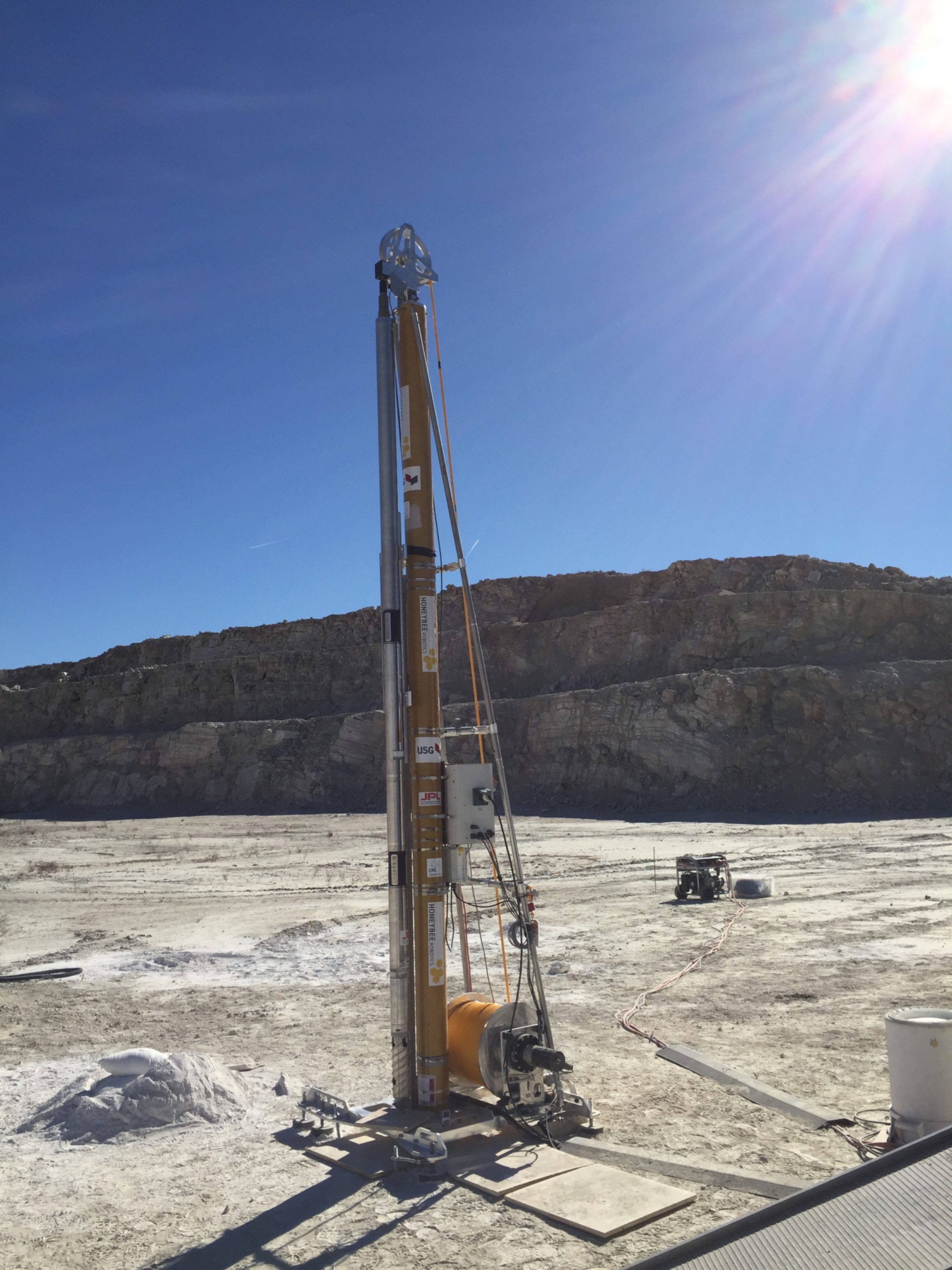
Planetary Defense
The Planetary Society is proud to once again be a primary sponsor of the biannual Planetary Defense Conference, which brings together experts on all aspects of the asteroid threat to Earth. The week-long conference will be held in spring 2019 in Washington, D.C.; we will cohost an affiliated public event at the University of Maryland. At the conference, we will present papers and report on the presentations of others. We will also announce a new call for proposals for our Gene Shoemaker Near-Earth Object grant program that supports highly skilled amateur astronomers around the world in their efforts to track and characterize near-Earth objects. Proposers will then have until 30 July to submit proposals to upgrade their observatories. Learn more about all our planetary defense efforts at planetary.org/defense.
LightSail 2 Still Awaiting Launch
As of this writing, we still await a new launch date for our solar sail spacecraft, LightSail 2, on a SpaceX Falcon Heavy rocket. The completed LightSail 2 spacecraft remains in clean room storage at Cal Poly San Luis Obispo, where we periodically recharge its batteries. In January, LightSail 2 underwent a successful required bake-out, spending several hours at high temperature to make sure any components that might release gases do so on Earth rather than in space.
When a launch date draws near, LightSail 2 will be taken to the Air Force Research Laboratory in Albuquerque and will be reintegrated with the Georgia Tech spacecraft Prox-1. They will then travel to Florida for integration with the Falcon Heavy rocket. When the launch draws closer, the team will hold another operational readiness test to practice procedures to be used in orbit. Learn more, including any updates on the launch date, at sail.planetary.org.
What's Up?
By Bruce Betts
In the Sky
In late March and early April, in the pre-dawn East there is a line of 3 planets, from super-bright Venus low down, to yellowish Saturn to its upper right, to bright Jupiter farther to the upper right. Venus gets lower in April and is joined by Mercury near the horizon. As weeks pass, Jupiter and Saturn get higher in the sky before dawn. In the evening sky, reddish Mars gets lower in the West as the weeks pass. Through April, it is not far from the brighter reddish star Aldebaran in Taurus. Mercury joins Mars very low in the West in June; they are very close on the 18th. By June, Jupiter is rising in the East in the early evening.
Random Space Fact
The most distant object ever encountered was the Kuiper belt object 2014 MU69 (unofficially nicknamed “Ultima Thule”) during the 1 January 2019 New Horizons flyby. The spacecraft was 6.6 billion kilometers (4.1 billion miles) from Earth during the encounter. The previous record holder was Pluto, which New Horizons encountered at a distance of 4.8 billion kilometers (3.0 million miles) from Earth.
Trivia Contest
Our June Solstice contest winner is Gary Green of Old Town, Maine, United States. Congratulations! The question was: What was the first human-made object to hit another world besides Earth? The answer: The Luna 2 spacecraft. It impacted the Moon in September 1959.
Try to win a copy of Astronomy for Kids: How to Explore Outer Space with Binoculars, a Telescope, or Just Your Eyes! by Bruce Betts and a Planetary Radio T-shirt by answering this question:
On what planet in our solar system have the fastest wind speeds been measured?
Email your answer to [email protected] or mail your answer to The Planetary Report, 60 S. Los Robles Ave., Pasadena, CA 91101. Make sure you include the answer and your name, mailing address, and email address (if you have one). By entering this contest, you are authorizing The Planetary Report to publish your name and hometown. Submissions must be received by 1 June 2019. The winner will be chosen in a random drawing from among all the correct entries received.
For a weekly dose of “What’s Up?” complete with humor, a weekly trivia contest, and a range of significant space and science-fiction guests, listen to Planetary Radio at planetary.org/radio.
Where We Are
An At-A-Glance Spacecraft Locator
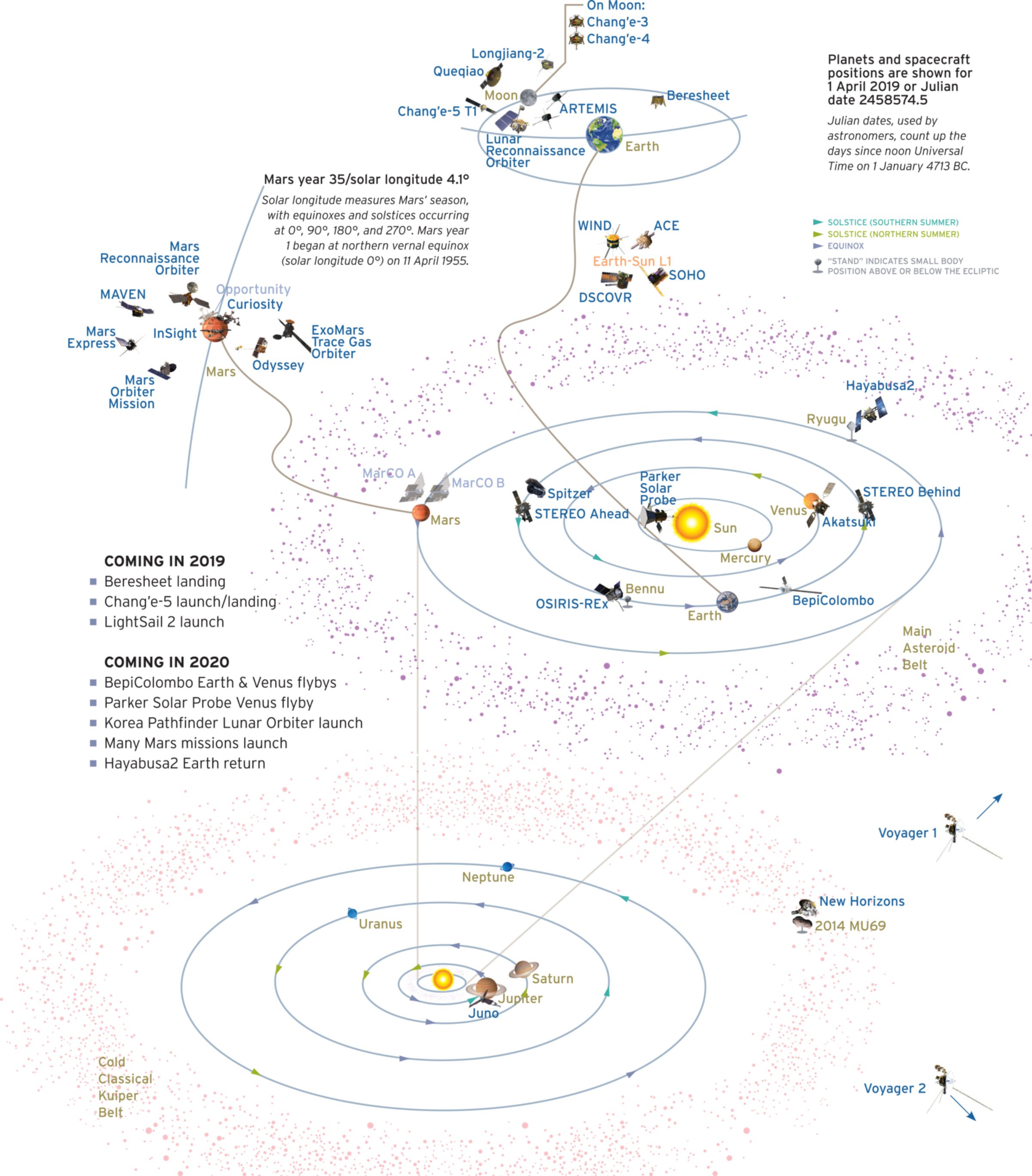
Astronomical Art

Miller placed a hypothetical Earth-sized ice world in orbit around a gas giant. He writes: “Covered with glaciers as deep as Greenland’s ice cap, the landscape is one of vast, canyon-sized cracks and fissures. With its sun only a distant, tiny star much smaller and dimmer than Earth’s, its future explorers would have to contend with temperatures falling below –200 degrees Celsius (–400 degrees Fahrenheit).”Image: Ron Miller, <a href="/multimedia/space-images/universe/www.black-cat-studios.com">Black Cat Studios</a>
The Planetary Report • March 2019
Help advance space science and exploration! Become a member of The Planetary Society and you'll receive the full PDF and print versions of The Planetary Report.


 Explore Worlds
Explore Worlds Find Life
Find Life Defend Earth
Defend Earth

